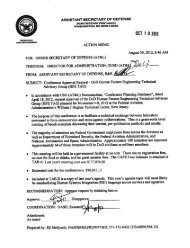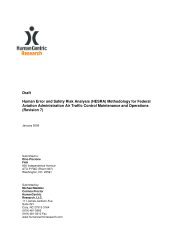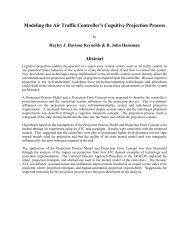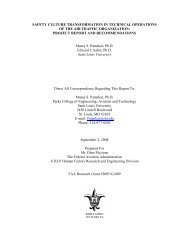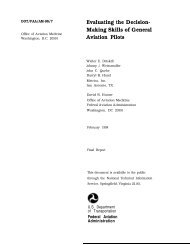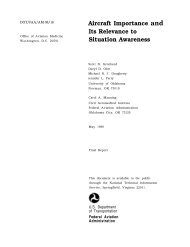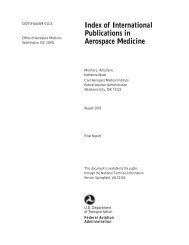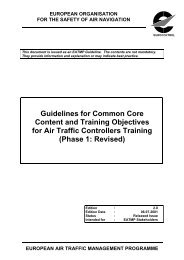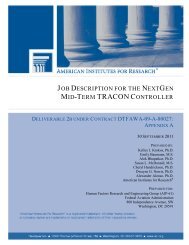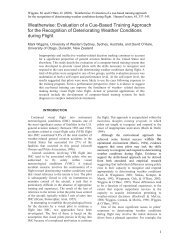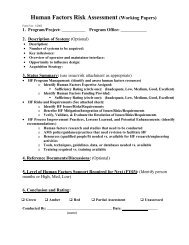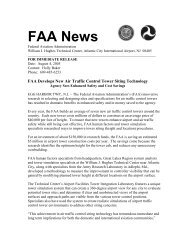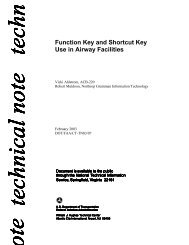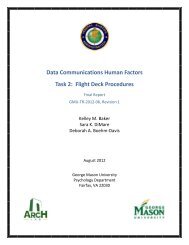job description for the nextgen mid-term atct controller - FAA Human ...
job description for the nextgen mid-term atct controller - FAA Human ...
job description for the nextgen mid-term atct controller - FAA Human ...
Create successful ePaper yourself
Turn your PDF publications into a flip-book with our unique Google optimized e-Paper software.
pronounced, negative ripple effect throughout <strong>the</strong> NAS. Many features of <strong>the</strong> current-day ATCT<br />
line <strong>controller</strong> <strong>job</strong> allow system users to transition seamlessly during <strong>the</strong>se phases of flight and<br />
effectively decrease those bottlenecks. The next Activity, <strong>the</strong> transfer of radar identification,<br />
describes how <strong>the</strong>se transitions can occur invisibly to <strong>the</strong> pilot and <strong>the</strong>reby help with overall<br />
system effectiveness.<br />
Current ATCT Activity 7: Transfer of Radar Identification<br />
As aircraft leave airspace controlled by one <strong>controller</strong> and enter ano<strong>the</strong>r <strong>controller</strong>’s airspace, <strong>the</strong><br />
<strong>controller</strong> responsible <strong>for</strong> that aircraft must effect a positive transfer of control. This requirement<br />
ensures in<strong>for</strong>mation integrity and makes sure that each aircraft is actively controlled by a single<br />
<strong>controller</strong> at any given time.<br />
ATCT line <strong>controller</strong>s per<strong>for</strong>m <strong>the</strong> function of radar identification transfer by initiating and<br />
receiving point outs and handoffs from o<strong>the</strong>r <strong>controller</strong>s by using <strong>the</strong> alphanumeric displays and<br />
data blocks (e.g., D-BRITE, RACD, TDW). This alphanumeric capability provides <strong>controller</strong>s<br />
with <strong>the</strong> ability to silently communicate with o<strong>the</strong>r <strong>controller</strong>s. Flight progress strips are also<br />
used to track and record in<strong>for</strong>mation. They receive requests, initiate automated and manual<br />
handoffs, and coordinate restrictions as necessary to transfer aircraft identification, position, and<br />
flight in<strong>for</strong>mation from one airspace jurisdiction to ano<strong>the</strong>r.<br />
Infrequently, ATCT line <strong>controller</strong>s initiate a radar “handoff” or “point out” to gain approval <strong>for</strong><br />
using ano<strong>the</strong>r <strong>controller</strong>’s airspace. During such instances, <strong>the</strong> <strong>controller</strong> receives <strong>the</strong> request,<br />
de<strong>term</strong>ines <strong>the</strong> need <strong>for</strong> coordination, ensures that conflicts have been resolved, and gives extra<br />
instructions to facilitate <strong>the</strong> operation. Appropriate coordination is made and in<strong>for</strong>mation is<br />
logged on flight strips or entered on <strong>the</strong> data block by <strong>the</strong> line <strong>controller</strong>. In <strong>the</strong> rare instance<br />
when such requests cannot be approved, <strong>controller</strong>s use alternative methods of routing, declaring<br />
radar contact to indicate that <strong>the</strong>y now accept responsibility <strong>for</strong> <strong>the</strong> aircraft and suppressing<br />
automated tracking in<strong>for</strong>mation accordingly.<br />
Controllers complete <strong>the</strong> transfer of aircraft in transit in <strong>the</strong> manner above to provide system<br />
users with a seamless transition along <strong>the</strong>ir route of flight. ATCT <strong>controller</strong>s continue to update<br />
and modify this in<strong>for</strong>mation in a manner that allows less frequency congestion, more situation<br />
awareness, and better overall system per<strong>for</strong>mance. These procedures allow aircraft to transition<br />
in a more positive control environment. Ano<strong>the</strong>r very important <strong>job</strong> Activity <strong>for</strong> <strong>controller</strong>s<br />
concerns <strong>the</strong> impact of wea<strong>the</strong>r on <strong>the</strong>ir operation. It is one of <strong>the</strong> most dynamic and challenging<br />
aspects of <strong>the</strong> <strong>job</strong>.<br />
Current ATCT Activity 8: Assess Impact of Wea<strong>the</strong>r<br />
Controllers must constantly observe wea<strong>the</strong>r conditions and evaluate whe<strong>the</strong>r and how <strong>the</strong>y will<br />
affect airport operations. Responding to changing wea<strong>the</strong>r conditions is critical because it gives<br />
aircraft operators <strong>the</strong> ability to avoid potentially unsafe conditions during ground movement and<br />
critical phases of flight.<br />
To respond appropriately to often rapidly changing wea<strong>the</strong>r conditions, <strong>controller</strong>s actively<br />
monitor and record in<strong>for</strong>mation (e.g., movement and intensity of winds or storms) that is<br />
ga<strong>the</strong>red by wea<strong>the</strong>r sensors. These data are typically displayed on automated surface observing<br />
systems (ASOSs), LLWAS, and Runway Visual Range (RVR) indicators. If <strong>the</strong> ATCT has a<br />
24



